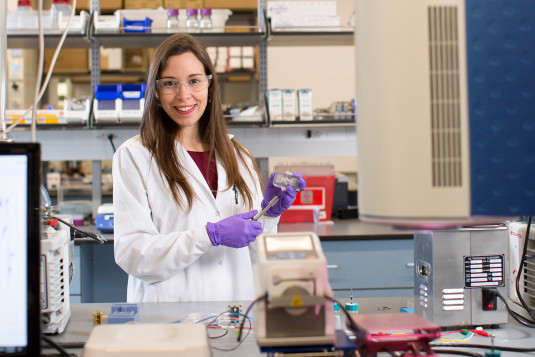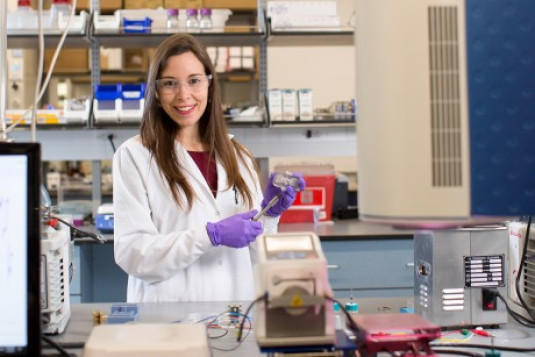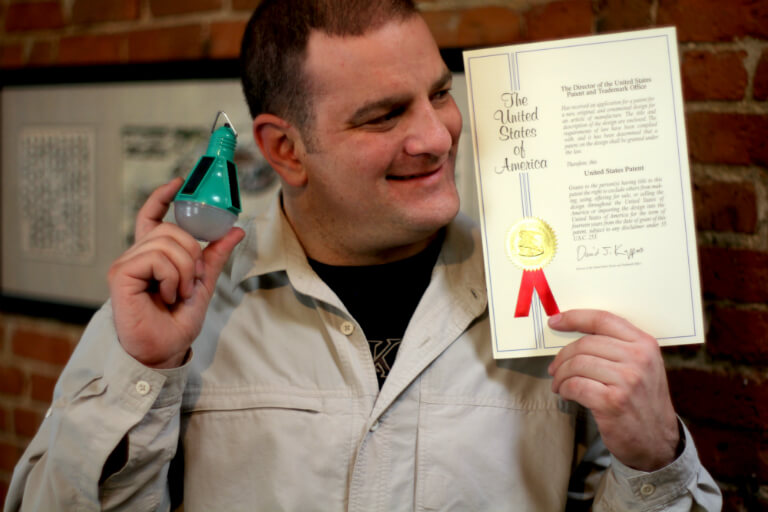
An end to darkness
Steve Katsaros, inventor of the Nokero solar light, didn’t plan on solving one of humanity’s primeval problems. But an unexpected “lightbulb moment” led to multiple U.S. patents, a new startup company, and hopefully a brighter future for the developing world.
6 min read
Each month, our Journeys of Innovation series shares the story of an inventor or entrepreneur whose innovation has made a positive difference in the world. Hear it in their own words or read the transcript below.
Do you know an innovator or entrepreneur with an interesting story?
Linda Hosler: 1.2 billion people in the world live without electricity. Every night many of them turn to kerosene lanterns to light their homes. But open flames have many risks. In addition to accidental burns and fires, kerosene is expensive, and the fumes are harmful to health. There has to be a better way, right?
I’m Linda Hosler at the United States Patent and Trademark Office.
Recently I spoke with Steve Katsaros of Denver, Colorado.
In 2010, Steve invented a low-cost solar light as a replacement for kerosene, helping millions of families in the developing world prevent illness and injury from fumes and fires. His startup, Nokero,- short for “no kerosene” - received the USPTO’s Patents for Humanity award for helping to bring affordable, renewable energy to the far-reaches of the globe.
Here’s a bit of insight from my phone conversation with Steve.
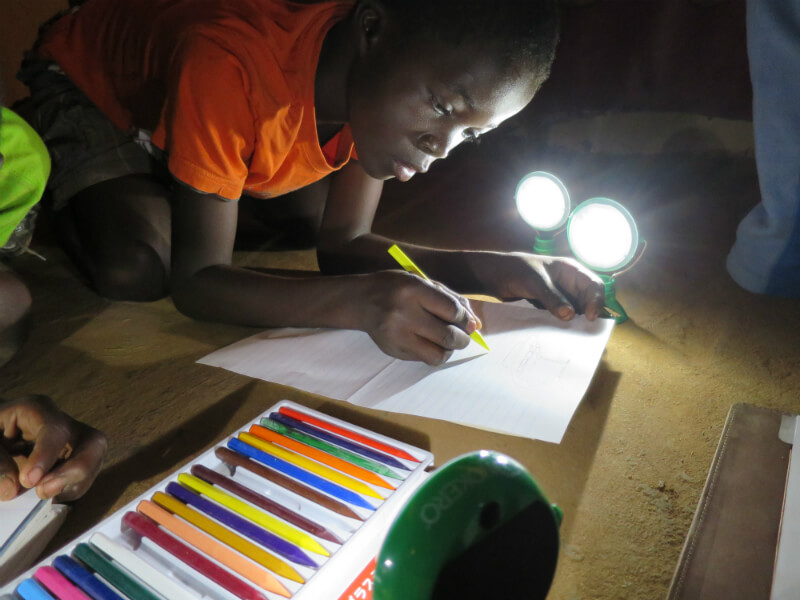
A child studies at night using the Nokero solar light.
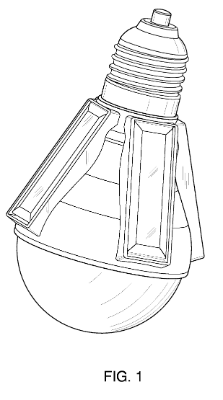
The patent drawing of the Nokero solar light.
Linda: We usually think of innovation as identifying a problem that needs to be solved. Could you talk about how you found the problem you wanted to solve and then how you went about solving it?
Steve Katsaros: Sure. So the genesis of Nokero is on January 24th of 2010, I went to bed thinking about construction lights we would see here in the U.S. where it’s like an extension cord, and just the idea popped into my head about, well why have it plugged in to a diesel generator? What if those were solar lights up there? And in the morning I woke up and sketched out the very first model of Nokero. So, I wasn’t thinking about the main problem we were going to solve, but back then I had the solution, but then within three days I identified that there were 1.2 billion people living without electricity. And that’s what really motivated this idea to move forward, was that it was a huge gift to humanity, and just an inventor quest, and solving a problem that really needs to be solved. And so, from that minute forward, it was all about no kerosene and the movement to remove kerosene lamps from the world.
Linda: That’s amazing. Yeah, I didn’t realize that you came up with the idea first and then found the market for it; that’s an interesting way that that happened.
Steve: I think you’ll find that with a lot of creatives -- that ideas pop in and you don't know what motivates it or where those ideas come from -- but innovation is nonlinear, true innovation is nonlinear. You can get to innovative products and ideas by identifying a problem and then running a process to solve that. But in this case, it was really just out of the blue.
Linda: You mention the sort of initial process, but could you talk a little bit about who helped you along the way? And how you took your idea from prototype to patent and then forward?
Steve: Boy, gosh, this is one of those questions where I could go on forever! The first thing I’d say is that we set a deadline. I told you that the date of conception was January 24th, and June 10th there was a business plan competition, and I used that a deadline. So, okay, we're going to launch this thing at the June 10th event, and then you just start working backwards from all the steps that need to occur from, you know, building prototypes, to getting production tooling made, to running the pilot production, and building a website and the ecommerce, and registering the entity. And so we just went, you know, obviously I just went, through a process of doing all of that. And then a little bit of luck happened. Somebody at that launch alerted CNN to what we were doing, and Ali Velshi at CNN interviewed me. And that went global, and we just were inundated from that point forward with inbound leads.
“True innovation is nonlinear.”
Linda: That’s amazing.
Steve: But that's the value of knowing intellectual property. We filed a patent within three days of conceiving the first product, and had cut the tooling, and built everything in five months, and had samples to hand out at that event. And, you know, we wouldn't have placed ourselves in a position where somebody said, ‘hey, there's a newsworthy thing, let's put it on CNN’ had we worried about people stealing the idea and...you know, my whole career has been around building products and inventing and engineering and so it was pretty, you know, we knew the steps.
Linda: Mhmm.
Steve: Intellectual property, and patents in particular, is just misunderstood. People think it's as simple as marching in and getting a patent and then you're gonna, you know, make all this money -- and it's not the case. There's a whole a sales effort around taking that patent and shopping it to the right licensees that want to commercialize the technology. But I say that because I feel that the industry is moving so fast right now that it's better to be collaborative and take the best of what an inventor does, which is come up with product ideas, and, then partner with the right marketing, and manufacturing, and logistics company that can roll it out to the masses.
Linda: Mhmm.
“Intellectual property, and patents in particular, is just misunderstood.”
Steve: Just remember to be a team player and partner with those that can help realize this dream of a better world through their invention. 8 million lives around the globe have been improved as a result of one spark of an idea, but you know, it's a drop in the ocean in comparison to the need that's out there.
Linda: Yeah.
Steve: But we're getting there.
Linda: Looking back at, and you just were talking about this-- looking at the impact of your invention, what are you most proud of?
Steve: I like pictures and stories that we get, where somebody has had an opportunity for education that they didn't have before. There's a boy named Joseph from Kenya that --unsolicited -- sent me an email and said you know, “…you don't know me. We've never met. Uh, some body purchased a couple of solar lights for, for me and my siblings. I'm the first one in university because I could study for hours every night when I couldn't before.” And you know now the trajectory of his family is going to be different because he's in college. Matter-of-fact, I think he's getting close to graduating. And I said, hey, well that’s great, but what happened to the lights? Where are they? “Oh my younger sister's using it now and uh, it works every day and is changing her life.” And I love that.
Linda: What an amazing story about the global impact of one good idea. From the United States Patent and Trademark Office, thanks for listening.

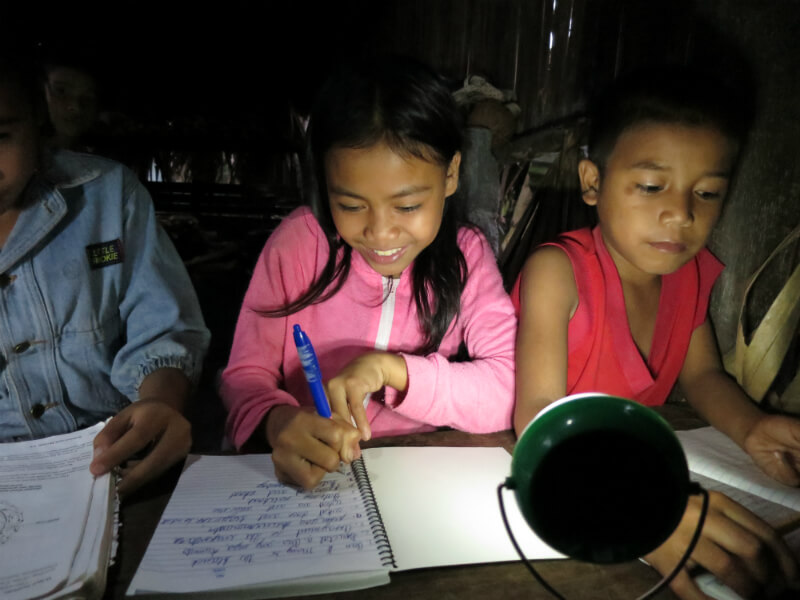
Students using the Nokero solar light at night and to study.

The Nokero light has had a global impact. Here, Katsaros poses with children who have been positively affected by his invention.


